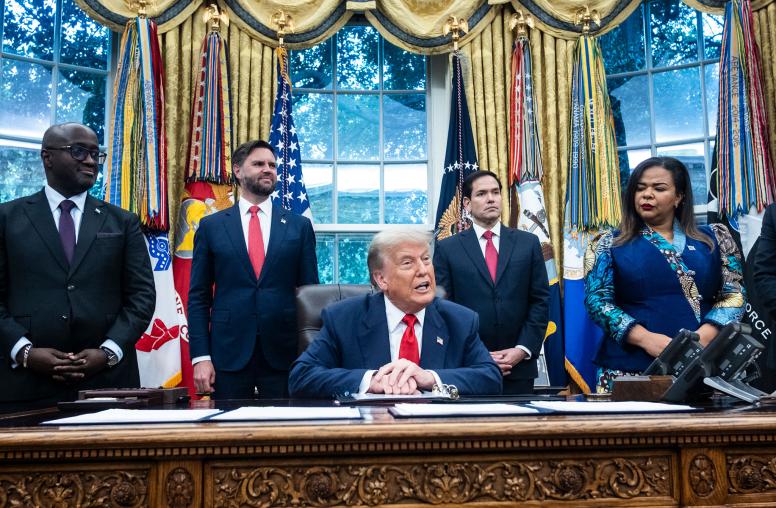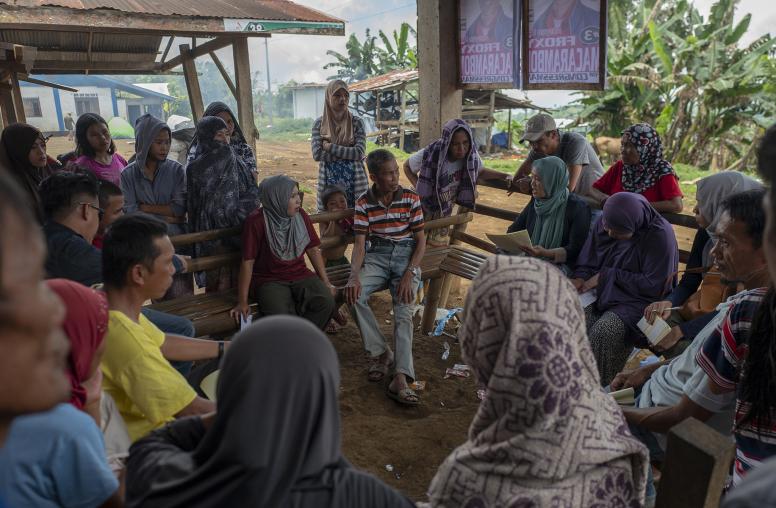2004-2005 Winning Essay
National First Place Winner
Jessica Perrigan
Duchesne Academy
Omaha, Nebraska
Coordinator: Ms. Virgie Oatman
Fukuzawa Yukichi, the foremost proponent of modern education in Japan, expressed an essential truth of civilization when he said “schools, industries, armies and navies are the mere external forms of civilization. They are not difficult to produce. All that is needed is the money to pay for them. Yet there remains something immaterial, something that cannot be seen or heard, bought or sold, lent or borrowed. It pervades the whole nation and its influence is so strong that without it none of the schools or the other external forms would be of the slightest use. This supremely important thing we must call the spirit of civilization.”1 That spirit of civilization must be cultivated through an effective educational system. Education provided the framework for a successful Japanese democracy, and its absence in Cambodia precipitated its demise in the 1970s.
The 1870s ushered an era of bunmei kaika, or “Civilization and Enlightenment,” into Japan.2 During this decade the works of great philosophers such as the de Tocqueville and Rousseau found their way into Japanese translation to the profound interest of the Japanese population, especially the youth.3 Students in Japan learned of the theories regarding civil liberties and natural rights, and began to claim that such rights were not only fundamental to Western societies, but to Japan as well. No book was more influential than Nakamura Masanao’s translation and occasional alteration of Samuel Smiles’ Self-Help. An entire generation grew up on Smiles and Masanao’s key theme: every person has the duty to work hard to cultivate his or her talents for the benefit of Japan and the world.4 By the 1880s, a so-called “People’s Rights Movement” enthusiastically challenged the divinity of the emperor and invoked natural rights, theories learned from the translated works of European philosophers. This direct challenge foreshadowed the official end of the emperor’s divinity sixty years later and began to pave the path for democracy.5
Only two decades earlier, such translations of Western works would not have been allowed into Japan. The Tokugawa Shogun—corrupt, decrepit, and highly traditional—forbade Western influence and only opened the ports of Japan to Western trade after “gun-boat diplomacy.” After the Shogunate’s fall in 1868, Japan turned eagerly toward Western ideas. Emperor Meiji soon realized that, to combat the stinging embarrassment of Western patronization, Japan would have to quickly institute political, social, and military reforms. Nowhere was the combination of the three more apparent than in Japan’s educational system.
Emperor Meiji did not face an uphill battle for educational reform: a high respect for learning was embedded in Japanese culture. The preamble of the Fundamental Code of Education, passed in 1872, embodies the optimistic spirit felt by the Japanese about educational modernization: “Learning is the key of success to life, and no man can afford to neglect it…Hereafter…every man shall, of his own accord, subordinate all other matters to the education of his children.”6 The Fundamental Code of Education made education not a matter for parental decision, but a child’s right. Among the reforms initiated by the Fundamental Code of Education was a mandate that required every boy and girl to attend school for at least four years, starting at age four.7 Perhaps even more important than compulsory education was the de-emphasis on Confucian morality in favor of more “Western” subjects such as practical sciences and the “development of the individual.” 8
Fifty years later, Japan’s World War II experience proved disastrous, and, as McNamara and Blight argue, “The unconditional surrender of …Japan made it possible for the United States and the West to force quick integration”9 of features of Western society, including the reorganization of Japan’s schools. One of America’s most pressing post-conflict tasks lay in the formation of a modern educational system in Japan.
In 1946, shortly after the beginning of the American occupation of Japan, a group of American educators arrived in Japan to modernize the education system. They immediately realized that the ultra-nationalistic curriculum favored before the war needed to be replaced with one that encouraged “individual dignity” and endeavored to “bring up people who love truth and peace.” In 1947, the newest “Fundamental” educational code took authority over the schools from a centralized ministry to local communities, and the Education of Ministry, the branch of the government that promulgated the nationalistic prewar and interwar curriculums, was stripped of all but oversight powers.10 Until new textbooks could be introduced, students and teachers took brush and ink to any pictures or words deemed militaristic in an effort to “democratize” school curriculums.11 In addition, “the elitism of the imperial universities [gave] way to a more egalitarian organization.”12 All of these reforms paved the way for Japan’s smooth transition to a world power. A literate society is a thinking society, and a thinking society institutes social change. Today, Japan’s schools are well-known for their intensity and for producing some of the brightest students in the world.13
In stark contrast to Japan’s cultural proclivity and respect toward education, the roots of education were never well-planted in Cambodia. For over one hundred years, until the end of World War II, Cambodia remained a French colony. The French did implement a rudimentary state education system, but only for the well-off. However, the French were much more involved in their more lucrative and well-known colony of Vietnam, and did not spread an educational system to the majority of the Cambodian population. Buddhist monks ran most other schools in their monasteries, called wats. 14
During the 1960s, Cambodia enjoyed a brief golden age of prosperity. Under the guidance of Norodom Sihanouk, the head of the country during the decade, the number of public schools nearly doubled.15 Sihanouk also established compulsory education for children and universities for native Cambodians. However, though Sihanouk was fond of the trappings of educational reforms, he did not really support social change. He forbade schools from addressing social equity or human rights, and essentially deprived schools of one of their fundamental purposes: to think about social problems and to encourage students to institute needed reforms. 16
After the betrayal of Norodom Sihanouk by Lon Nol, his right-hand general, Cambodia’s already shaky political infrastructure swayed even closer to collapse. Lon Nol, worried about maintaining power, did not continue educational reforms. 17 As unrest grew in Cambodia, a small communist group known as the Khmer Rouge fed on people’s fears and rapidly gained power until the Cambodian civil war broke out. With the victory by the Khmer Rouge, a former electrical student originally named Saloth Sar but known to the world as Pol Pot, would have complete control over Cambodia’s educational system. During the Khmer Rouge’s spectacularly brutal reign, a time in which the “blood of Vietnam” spilled over Cambodia’s borders to inspire frenzied revolutionary terror, formal education ended. 18 “My,” a survivor of the Cambodia genocide, described the end of schooling in Cambodia: “The Khmer Rouge divided the kids up into age categories. The older ones were sent off to another camp. The pre-teen kids were weeders and rice planters. My sons had a green thumb, so the Khmer Rouge told them to plant rice,” instead of attend school. 19 Chanrinthy Him, a survivor of the Khmer Rouge, wrote after the genocide that “it [had] been six years since I attended formal school. Now, at fifteen, I enroll in the seventh grade, two grades higher than when I lived in Phnom Penh”20 [before the Khmer revolution].
Schools were transformed into prisons where political opponents were tortured. The Khmer Rouge “aimed to create a society based on ignorance and obedience.”21 During the Khmer Rouge’s rule, the wearing of glasses, the “mark of a civilized person,” was outlawed and the use of any language beside Khmer meant death for the speaker, because knowledge of a foreign language was a mark of education and therefore a threat to national unity.22 In addition to the destruction of schools, the Khmer Rouge effectively destroyed Buddhism in Cambodia, thereby ending the most accessible form of education for most Cambodians. Pol Pot believed that the “totally indoctrinated,” or totally uneducated, would be able to construct a completely equal country without feudalistic overtones introduced by education.23
If education was not the key to democracy, why would dictators such as Pol Pot go to such lengths to deny it to the population? Democracy is a government for the thinking, and for a country to have a sustained cultural movement toward democracy, its population must be taught to reason and to search for knowledge. The process of education provides the means by which a population may institute social change and the basis of individual development, without which democracy will not succeed. The responsibility of nations like the United States and organizations like the United Nations is to implement and fund successful systems of education in Third World countries. Teachers and textbooks must be supplied and a curriculum based on a country’s culture must be planned and executed if countries without a democratic system of government now can ever become democratic.
Endnotes
1.James L. McClain, Japan: A Modern History (New York: W.W. Norton and Company, 2002), 178.
2.Ibid., 169.
3.Ibid., 175.
4.Ibid., 176.
5.Ian Buruma, Inventing Japan: 1863-1964 (New York: The Modern Library, 2003), 42.
6.Marius B. Jansen, The Making of Modern Japan (Cambridge: Harvard University Press, 2000), 403.
7.McClain, op. cit., 179.
8.Ibid., 181.
9.Robert S. McNamara and James G. Blight, Wilson’s Ghost: Reducing the Risk of Conflict, Killing, and Catastrophe in the 21st Century (New York: PublicAffairs, 2001), 64.
10.Patrick Smith, Japan: A Reinterpretation (New York: Pantheon Books, 1997), 98.
11.John W. Dower, Embracing Defeat: Japan in the Wake of World War II (New York: W.W. Norton and Company, 1999), 247.
12.Jansen, op. cit., 680.
13.The Japanese Foundation, “Japanese Studies and Intellectual Exchange”; available at http://www.jpf.go.jp/e/intel/index.html; Internet; accessed 19 January 2005.
14.Robert Green, Modern Nations of the World: Cambodia (San Diego: Lucent Books, 2003), 78.
15.Green, op. cit., 79.
16.David Chandler, A History of Cambodia (Boulder: Westview Press, 1996), 204.
17.Bruce Sharp, “The Banyan Tree: Untangling Cambodian History”; available at http://www.mekong.net/cambodia/banyan1.htm; Internet; accessed 20 January 2005.
18.Francois Bizot, The Gate (New York: Alfred A. Knopf, 2003), 5.
19.Three Women: Oral Histories, “My”; available at http://www.mekong.net/cambodia/3women2.htm. Internet, accessed 20 January 2005.
20.Chanrithy Him, When Broken Glass Floats: Growing Up under the Khmer Rouge (New York: W.W. Norton and Company, 2000.
21.Green, op. cit., 70.
22.Ian Mabbett and David Chandler, The Khmers (Cambridge: Blackwell Publishers, 1998), 240-245.
23.Ibid., 248.
Bibliography
Primary Sources
Bizot, Francois. The Gate. New York: Alfred A. Knopf Publishers, 2003.
Him, Chanrithy. When Broken Glass Floats: Growing Up under the Khmer Rouge. New York: W.W. Norton and Company, 2000.
Three Women: Oral Histories. “My.” Available at available at http://www.mekong.net/cambodia/3women2.htm. Internet, accessed 20 January 2005.
Vincent Ferraro, Resources for the Study of International Relations and Foreign Politics. “Emperor Hirohito, Accepting the Potsdam Declaration, Radio Broadcast.” Available from http://www.mtholyoke.edu/acad/intrel/hirohito.htm. Internet, accessed 28 January 2005.
Secondary Sources
Buruma, Ian. Inventing Japan: 1853-1964. New York: The Modern Library, 2003.
Chandler, David. A History of Cambodia. Boulder: Westview Press, 1996.
Dower, John W. Embracing Defeat: Japan in the Wake of World War II. New York: W.W. Norton and Company, 1999.
Green, Robert. Modern Nations of the World: Cambodia. San Diego: Lucent Books, 2003.
Jansen, Marius B. The Making of Modern Japan. Cambridge: Harvard University Press, 2000.
Mabbett, Ian and David Chandler. The Khmers. Cambridge: Oxford Press, 1995.
McClain, James L. Japan: A Modern History. New York: W.W. Norton and Company, 2002.
McNamara, Robert S. and James G. Blight. Wilson’s Ghost: Reducing the Risk of Conflict, Killing, and Catastrophe in the 21st Century. New York: PublicAffairs, 2001.
Sharp, Bruce. “The Banyan Tree: Untangling Cambodian History.” Available at http://www.mekong.net/cambodia/banyan1.htm. Internet, accessed 20 January 2005.
Smith, Patrick. Japan: A Reinterpretation. New York: Pantheon Books, 1997.
The Japanese Foundation. “Japanese Studies and Intellectual Exchange.” Available at http://www.jpf.go.jp/e/intel/index.html. Internet, accessed 19 January 2005.




